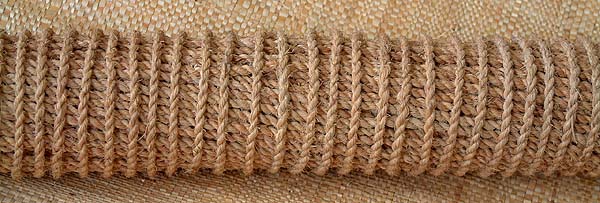| Canoe Equipment:
|
|
|
"This model is not a sailing canoe, it’s a paddling canoe," Steve says. "But in my home island, those young boys, they make their sails for their paddling canoes, to go out in the lagoon for a race. And some people used to go outside the lagoon for trolling, so they got tuna and barracuda or those kinds of fish, using the paddling canoe. They make a sail and go out, and if there is the wind, then they use the sail. (1) “Now this kind of sail you can switch from end of the canoe to the other. But you see, there is no rope. You can sit here and just pull up the sail, and turn, put this in. And this rope is for pulling in and letting out the sail, to catch the wind. You sit here and you hold this one, because you adjust your canoe. When the wind comes very strong, and you pull it hard, the canoe will flip over. So if the outrigger is coming up when there is a strong wind, then you release the sail, then it’s calming down again.” (2) “This item on the end of the sail, that’s decoration. Every canoe, they use this one. If there is not this one, it may be bad luck. That’s a decoration; when you get them, it’s really good." (3) "This stick, this is used for when something attacks you, like a shark. That’s why it’s sharp. So when something attacks you, you kill it using this stick. And also, when there is strong wind, you use this large paddle to paddle to the reef. If you cannot paddle, use this pole. Stand at the back of your canoe and poll it in, if it’s shallow enough." (4) "The small paddle is for only when it’s calm, then you can use the small one. The larger one is for rough weather." (5) “And also you have a bailer. You have to take this one—if you don’t take it, oh, man, you’re going to be sorry! Before you go out, you have to check everything. Bailer and paddles." (6) “These two ropes, you can use it for an anchor, or if something happens, like the outrigger breaks, when it’s broken then you take this stick out, you break the stick, and then you tie it to the broken support. So you can go back home. But if you don’t have rope or stick…. “But this canoe, even if the outrigger supports break—both of them—he can just simply tie them up and continue on sailing,” Mariano adds. “So you have to take a rope and at least two pieces of sticks. The most danger is when these support pieces are broken. And you have to know how to tie them.”
|
||
|
|
||
|
"Now, about knot tying," Mariano continues, "all this knowledge of different knots and lashings are kept secret, unless you paid to learn this. So if we are traveling on a canoe and lets say you’re from a different clan, I’m from a different clan. And our canoe breaks in the water on the open sea. We need to tie the canoe’s two pieces together. So I’ll do my tying, with a secret slip knot some where, just so that we can reach an island. "But upon reaching that island, I’m going to slip that knot, so the canoe falls back into two pieces, without my companion from another clan learning how to do that knot. "He will know his own technique. So if it’s only the two of us, and both ends of the canoe break, you’ll tie that end, I tie this other end. So when we reach the island, you will slip your knot, I will slip mine. And the canoe will just fall into pieces.”
|
||
|
|
||
Canoe Carving | Equipment
|
|
|||||
|
|||||


